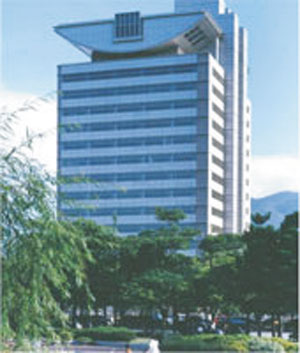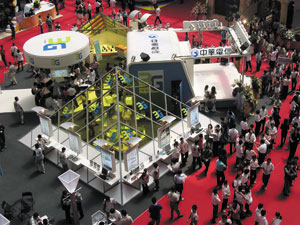Premier Wu Promises to Popularize Intelligent Green Buildings in Taiwan
Building green can help Tai
2010/03/04 | By Ken LiuTaiwan's Premier Den-yih Wu designated in early January four key strategic industries to be developed in 2010, including intelligent green building, cloud computing, EVs (electric vehicles) and intellectual property licensing.

The premier promised to make green buildings more widely available and affordable to the public in Taiwan, setting the stage to perhaps generate more lucrative business opportunities, especially for those that can integrate information-communication technology (ICT) with construction and eco-friendliness technologies.

Taking the high road, the premier said that Taiwan is well poised to realize intelligent green buildings by being the world's No.1 supplier of ICT products, adding that combining ICT products with green construction will enable Taiwan to significantly improve quality of life and industry.
Defined by ABRI
As defined by Taiwan's Architecture and Building Research Institute (ABRI) of the Ministry of Interior, an intelligent green building integrates architectural, green and ICT technologies. The ABRI director general M.J. Ho says the institute will work with the Ministry of Economic Affairs (MOEA) to set up a platform to offer intelligent-residential functions that fully tap ICT.
Such functions enhance residential safety, convenience and energy efficiency, by addressing such needs in senior homes, and even remote controlling household appliances via Internet-enabled mobile phones. With intelligent management system in place, housewives can use handheld devices to switch on washers, air conditioners etc. before even arriving home, making housework more organized and convenient. Although builders in Taiwan know intelligent green building concepts, but they have equipped such technologies in only a few projects, says Ho.
Ho says that the platform will develop wide-ranging green intelligent networks applicable to either new or old buildings. To make it achievable, the ABRI is studying the feasibility of writing intelligent green building codes into the Building Act and Electricity Act or even the Telecommunications Act, to replace cables with wireless technologies as the backbone of green, intelligent buildings and management.
The director also says that the ABRI will start the green plan with trials in schools and government buildings in Jingmei District, Taipei City, integrating all intelligent functions and later extending the experiments into central and southern Taiwan. The ABRI will work with the National Science Council (NSC) and MOEA to develop a coordinated intelligent green building policy and incentives to encourage builders to construct such structures, as well as consumers to buy them.
Real-world Example
Citing Incheon in South Korea, benefiting from an intelligent green building plan, M.W. Hsu, CEO of the semi-official Taiwan Architecture & Building Center (TABC), estimates the city of three million or so could save about a third in electricity. Also the plan is creating some US$15 billion in business and 375,000 jobs, he says.
Hsu points out the true value of intelligent green buildings: More than merely saving electricity and upgrading convenience in daily routines, but such buildings minimize wasting resources to allow more eco-friendly living. Actually minimal energy saving is realized if the plan covers only a few buildings; but the benefits are enormous with whole communities or even cities involved. Replacing security guarding and caretaking of elderly, for examples, with intelligent home management will save transporting personnel and reduce CO2 emissions, he notes; while other benefits are achieved, such as reducing traffic congestion, vehicle accidents, noise pollution etc.
An intelligent city, the CEO stresses, should use natural resources rationally to better preserve them for the next generation. Therefore, such a plan should combine coexistence of human in nature, energy conservation, emissions reduction, and eco- friendliness. People should live eco-friendly lives rather than just talk about it, he urges.
The Liaison
The TABC, following primer Wu's announcement, will be the liaison between Taiwan's homebuilders and ICT suppliers, acting as information exchange platform to facilitate technological integration between the two parties.
Over the past 10 years, the nonprofit TABC has helped develop several verification systems for Taiwan's green building and intelligent building industries, having introduced the “Green Building Label” in 1999 and “Intelligent Building Label” in 2002.
Structures with the Green Building Label meet the 30% green material requirement, with such stipulation having taken effect on July 1, 2009 and upgraded from 5% in the Building Act. Constructions with the “Intelligent Building Label” meet at least four of the seven official standards: information communication, disaster prevention, well-being, energy conservation, system integration, facility management, and generic cabling.
Hsu says that Taiwan is the world's fourth economy to set up the “Green Building Label” system, with the TABC, till mid-2009, having labeled 368 buildings as green.
More than just purely ecological, Hsu notes that the official intelligent green building policy has a commercial side: To help Taiwan's intelligent green building industry generate business, by offering high value-added know-how to markets worldwide.
Seven Eco-formulas
Architectural professor M.J. Cheng of Feng Chia University in central Taiwan, who was funded in 2008 by MOI to develop green, intelligent solutions for residences, came up with seven eco-formulas: Enclose buildings with vegetation fencing instead of brick and mortar; plant vines on walls; build rainwater recycling pools to top up groundwater; install solar panels on roofs to heat water and generate electricity; use beam structure and other eco-friendly materials instead of reinforced concrete; use energy-saving lighting; and outfit buildings with water-efficient plumbing and use recycled rainwater.
Justifying the above eco-friendly measures, Cheng says that vegetation fencing absorbs CO2 gas and noise as well as beautifies environments; vines help convert CO2 to oxygen and cool off interior air; refilling ground water helps maintain eco-balance by nurturing microorganisms in soil and cool off ambient air; solar panels help reduce CO2 production; beam structure and recyclable materials can be reused and reduce greenhouse gases from manufacturing relative to making concrete; and water-saving plumbing and recycling rainwater reduce water usage.
Cheng stresses that rising eco-awareness due to global warming and energy crisis has sparked a significant trend: Architects in industrially advanced countries are stressing harmony between man and Mother Nature, instead of only aesthetics and functionality. “Adding ICT to green buildings will not dilute the dominant themes of ecology, energy saving, greenhouse gas reduction and well-being,” he says.
More reason to advocate green building lies in the study recently released by MOI's Architecture and Building Research Institute, which notes that conventional construction, and later occupation by residents, consume huge amounts of energy and resources, with ample pollution generated upon dismantling.
Further warranting the promotion of green construction, Dr. W.C. Chen, a materials specialist at the Energy and Resources Laboratories of the official Industrial Technology Research Institute who helped draft parameters for green building materials, says such program is critical in Taiwan since the island's building industry burns a quarter of the total energy consumed.
Revealing a silver lining to this dark cloud, Dr. Chen estimates that eco-friendly building materials can potentially command around 15% or NT$30 billion (about US$937 million) of Taiwan's building materials market, valued at around NT$200 billion (US$6.2 billion), in a few years.




